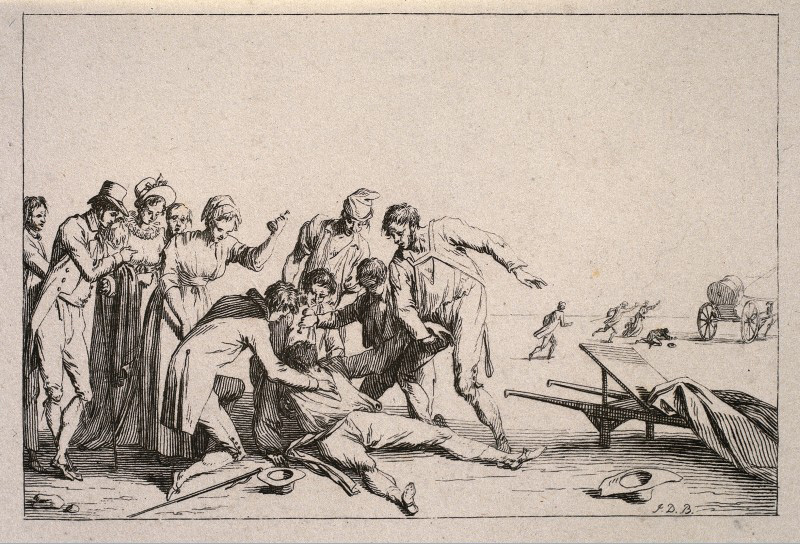
A group of people stand around a man having an epileptic seizure.
Etching by J. Duplessi-Bertaux (1747–1818)
Wellcome Images (The Wellcome Trust, Ltd.)
Most of the time, epilepsy is an invisible disability. That is, until it strikes unexpectedly. Epilepsy is a disease of the brain characterized by seizures, uncontrolled and involuntary spasms. This condition lurks in more than 2 million children and adults in the U.S., 1 in 26 people. November is National Epilepsy Awareness Month. The Epilepsy Foundation notes that although people with epilepsy have special needs that are often misunderstood, they can and do lead ordinary and extraordinary lives.
The theme this year is #AimForZero, referring to the four steps people with epilepsy and their caretakers should take to prevent sudden unexpected death from epilepsy. These are:
- Taking medication as prescribed
- Getting enough sleep
- Limiting alcohol consumption
- Striving to stop seizures.
It is important to distinguish between epilepsy and a seizure. When someone has had more than one unexplained seizure (for example, not due to head trauma), “the underlying and enduring tendency to have seizures,” that person is considered to have epilepsy.
According to the Centers for Disease Control and Prevention (CDC) and the World Health Organization (WHO), there many types of seizures, ranging from a temporary state of confusion to a series of convulsions serious enough to cause the person to fall, shake, and become unaware of what is happening. These include the following:
- Tonic-clonic: Formerly also called grand mal, these seizures are what most people picture when they think of seizures. Tonic-clonic seizures can cause a person to fall to the ground, go into convulsions, cry out, or lose consciousness. (Tonic describes muscles that become stiff; clonic refers to periods of shaking of parts of the body.)
- Absence: Formerly also called petit mal, these seizures are often brief and involve staring.
- Atonic: These seizures cause muscles to lose tone. If the person is sitting, the head will droop; if the person is standing, he or she will drop to the ground. Persons who have these seizures frequently may have to wear protective head gear.
- Myoclonic: These are brief shock-like jerks of a muscle or group of muscles.
Know What to Do
Even among the population at large, about 1 of 10 people has had a seizure at some point in his or her life. Therefore, it is very important to know what to do, especially in the case of a tonic-clonic seizure:
- Keep calm. Ease the person to the floor to prevent injury from a fall. Do not hold the individual down; doing so could hurt you or the person.
- Place a soft and flat object such as a folded shirt or jacket under the person’s head to avoid injury and keep it inclined. This also ensures that he or she won’t choke on saliva.
- Turn the person gently onto one side to help him or her breathe and further prevent choking.
- Clear the surrounding area of anything hard or sharp to avert possible injury.
- If the space is crowded, request those present to clear the area.
- Remove eyeglasses or sharp jewelry; loosen ties or anything around the neck.
- Time the seizure. If the seizure lasts longer than five minutes, call 9-1-1. In addition, check for a medical-alert bracelet.
Did You Know?

The great Greek physician Hippocrates (c. 460-370 B.C.) was one of the earliest advocates for people with epilepsy by rejecting the notion that people with the condition were somehow spiritually possessed. However, evil spirits would continue to be cited into the 1600s.
- Epilepsy affects at least 50 million people worldwide. This figure is greater than the number of people with autism, Parkinson’s disease, multiple sclerosis, and cerebral palsy combined. Equally perplexing, 70 percent of cases of epilepsy have no known cause.
- Descriptions of epilepsy are as old as writing itself. The ancient Greeks called epilepsy the “Sacred Disease,” in the belief that the condition was, on the one hand, a form of spiritual possession and, on the other, a sign of genius and the divine. The famous physician Hippocrates rejected this notion, citing heredity as the cause.
- The terms grand mal and petit mal had been used for many years, even among physicians. However, as they are French for “large evil” and “small evil,” they gradually become unpopular among people with epilepsy and are no longer used.
- About 1 in 26 persons in the U.S. will develop epilepsy sometime in his or her lifetime, according to the CDC. That is 2.2 million Americans. In addition, some 3.4 million people in the U.S. live with active epilepsy.

Elsewhere in Greek mythology, Hephaistos, the god of the forge, was exiled from Mount Olympus, the throne and home of the gods. Why? He was born with a limp, something we would today recognize as a disability. It is noteworthy, however, that he was later returned.
Wellcome Images (The Wellcome Trust, Ltd.)


